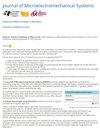Synchronized Opto-Electro-Mechanical Measurements for Estimation of Energy Dissipation in Thin-Film-Piezoelectricon-Substrate MEMS/NEMS Devices
IF 3.1
3区 工程技术
Q2 ENGINEERING, ELECTRICAL & ELECTRONIC
引用次数: 0
Abstract
Piezoelectric microelectromechanical systems have significant market potential owing to their superior capabilities of transduction to those of standard capacitive and piezoresistive devices. However, piezoelectric films are often lossy, which reduces the Quality Factor of devices and affects their performance. It is thus important to examine all sources of energy dissipation in such devices and accurately determine them based on experimental data. Currently used methods to quantify energy dissipation from different sources and the properties of materials based on experimental data are set-up for piezoelectric devices, in which energy storage and dissipation primarily occur in the same piezoelectric material. Moreover, such methods rely on resonance-antiresonance measurements, and thus are unsuitable for thin-film-piezoelectric-on-substrate (TPoS) Micro/Nano devices that have i) a significant portion of energy stored in the substrate/device layer, ii) a low signal-to-noise ratio owing to either lossy piezoelectric films or high motional impedance, or iii) a larger feedthrough capacitance, arising primarily from collocated electrodes, in addition to the internal capacitance of the piezoelectric film. In this paper, we propose a method that overcomes these challenges based on synchronized optical and electrical measurements. We develop a comprehensive physics-based model to extract all the relevant parameters for the device, including the coefficient of piezoelectric coupling, internal and feedthrough capacitance, loss tangents (dielectric, piezoelectric, and mechanical), and the contributions of different sources to the Quality Factor of the device. We showcase the proposed method by using a PZT-based TPoS MEMS cantilever and a Piezoelectric Micromachined Ultrasonic Transducers (PMUT).[2024-0063]薄膜压电基板MEMS/NEMS器件能量耗散的同步光电-机械测量方法
压电式微机电系统由于其优于标准电容式和压阻式器件的转导能力而具有巨大的市场潜力。然而,压电薄膜往往存在损耗,这降低了器件的质量因子,影响了器件的性能。因此,重要的是检查这些装置的所有能量耗散源,并根据实验数据准确地确定它们。目前常用的基于实验数据的压电器件能量耗散量化方法是建立在能量存储和耗散主要发生在同一压电材料中的压电器件。此外,这些方法依赖于共振-反共振测量,因此不适用于薄膜压电基板(TPoS)微纳米器件,这些器件具有i)很大一部分能量存储在基板/器件层中,ii)由于有损耗的压电薄膜或高运动阻抗而具有低信噪比,或者iii)除了压电薄膜的内部电容外,主要由配置的电极产生的更大的馈通电容。在本文中,我们提出了一种基于同步光学和电学测量的方法来克服这些挑战。我们开发了一个全面的基于物理的模型来提取器件的所有相关参数,包括压电耦合系数,内部和馈通电容,损耗切线(介电,压电和机械),以及不同来源对器件质量因子的贡献。我们通过使用基于压电陶瓷的TPoS MEMS悬臂和压电微机械超声换能器(PMUT)展示了所提出的方法。[2024-0063]
本文章由计算机程序翻译,如有差异,请以英文原文为准。
求助全文
约1分钟内获得全文
求助全文
来源期刊

Journal of Microelectromechanical Systems
工程技术-工程:电子与电气
CiteScore
6.20
自引率
7.40%
发文量
115
审稿时长
7.5 months
期刊介绍:
The topics of interest include, but are not limited to: devices ranging in size from microns to millimeters, IC-compatible fabrication techniques, other fabrication techniques, measurement of micro phenomena, theoretical results, new materials and designs, micro actuators, micro robots, micro batteries, bearings, wear, reliability, electrical interconnections, micro telemanipulation, and standards appropriate to MEMS. Application examples and application oriented devices in fluidics, optics, bio-medical engineering, etc., are also of central interest.
 求助内容:
求助内容: 应助结果提醒方式:
应助结果提醒方式:


